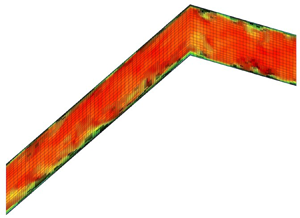Crossref Citations
This article has been cited by the following publications. This list is generated based on data provided by
Crossref.
Mehta, Yash
Nejadmalayeri, Ari
and
Regele, Jonathan David
2021.
Computational Fluid Dynamics Using the Adaptive Wavelet-Collocation Method.
Fluids,
Vol. 6,
Issue. 11,
p.
377.
Ge, Xuan
De Stefano, Giuliano
Hussaini, M.
and
Vasilyev, Oleg
2021.
Wavelet-Based Adaptive Eddy-Resolving Methods for Modeling and Simulation of Complex Wall-Bounded Compressible Turbulent Flows.
Fluids,
Vol. 6,
Issue. 9,
p.
331.
Kevlahan, Nicholas K.-R.
2021.
Adaptive Wavelet Methods for Earth Systems Modelling.
Fluids,
Vol. 6,
Issue. 7,
p.
236.
Rossano, Viola
and
De Stefano, Giuliano
2021.
Computational Science and Its Applications – ICCSA 2021.
Vol. 12949,
Issue. ,
p.
376.
Rossano, Viola
and
De Stefano, Giuliano
2021.
Computational Evaluation of Shock Wave Interaction with a Cylindrical Water Column.
Applied Sciences,
Vol. 11,
Issue. 11,
p.
4934.
Kasimov, Nurlybek
Dymkoski, Eric
De Stefano, Giuliano
and
Vasilyev, Oleg V.
2021.
Galilean-Invariant Characteristic-Based Volume Penalization Method for Supersonic Flows with Moving Boundaries.
Fluids,
Vol. 6,
Issue. 8,
p.
293.
Ge, Xuan
Vasilyev, Oleg V.
and
Hussaini, M. Yousuff
2021.
Wavelet-based adaptive wall-modeled large eddy simulation method for compressible turbulent flows.
Physical Review Fluids,
Vol. 6,
Issue. 9,
De Stefano, Giuliano
and
Vasilyev, Oleg V.
2021.
Hierarchical Adaptive Eddy-Capturing Approach for Modeling and Simulation of Turbulent Flows.
Fluids,
Vol. 6,
Issue. 2,
p.
83.
Qi, Han
Li, Xinliang
Hu, Running
and
Yu, Changping
2022.
Quasi-dynamic subgrid-scale kinetic energy equation model for large-eddy simulation of compressible flows.
Journal of Fluid Mechanics,
Vol. 947,
Issue. ,
De Stefano, Giuliano
Dymkoski, Eric
and
Vasilyev, Oleg V.
2022.
Localized dynamic kinetic-energy model for compressible wavelet-based adaptive large-eddy simulation.
Physical Review Fluids,
Vol. 7,
Issue. 5,
Rossano, Viola
and
De Stefano, Giuliano
2022.
Hybrid VOF–Lagrangian CFD Modeling of Droplet Aerobreakup.
Applied Sciences,
Vol. 12,
Issue. 16,
p.
8302.
Rossano, Viola
Cittadini, Amedeo
and
De Stefano, Giuliano
2022.
Computational Evaluation of Shock Wave Interaction with a Liquid Droplet.
Applied Sciences,
Vol. 12,
Issue. 3,
p.
1349.
De Stefano, Giuliano
2023.
Wavelet-based adaptive large-eddy simulation of supersonic channel flow with different thermal boundary conditions.
Physics of Fluids,
Vol. 35,
Issue. 3,
Yang, Bing
Wang, Jizeng
Liu, Xiaojing
and
Zhou, Youhe
2023.
Stability and Resolution Analysis of the Wavelet Collocation Upwind Schemes for Hyperbolic Conservation Laws.
Fluids,
Vol. 8,
Issue. 2,
p.
65.
Alam, Jahrul M
2023.
Wavelet Transforms and Machine Learning Methods for the Study of Turbulence.
Fluids,
Vol. 8,
Issue. 8,
p.
224.
Rossano, Viola
and
De Stefano, Giuliano
2023.
Testing a Generalized Two-Equation Turbulence Model for Computational Aerodynamics of a Mid-Range Aircraft.
Applied Sciences,
Vol. 13,
Issue. 20,
p.
11243.
Mezzacapo, A.
Vitulano, M. C.
Tomasso, A. D.
and
De Stefano, G.
2023.
Computational Science and Its Applications – ICCSA 2023.
Vol. 13956 ,
Issue. ,
p.
113.
Vasilyev, O. V.
Zhdanova, N. S.
and
Kluev, N. A.
2024.
Comparative Study of Conventional and Penalized Wall Function Methods in Turbulent Flow Modeling.
Mathematical Models and Computer Simulations,
Vol. 16,
Issue. S1,
p.
S139.
De Stefano, G.
and
Vasilyev, O. V.
2024.
Direct and Large Eddy Simulation XIII.
Vol. 31,
Issue. ,
p.
197.
Mezzacapo, Antonio
and
De Stefano, Giuliano
2024.
Computational Science and Its Applications – ICCSA 2024.
Vol. 14814,
Issue. ,
p.
366.


